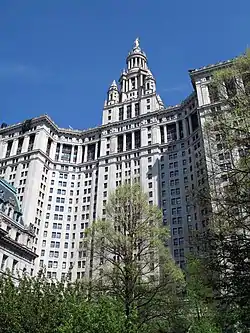280 Broadway
280 Broadway – also known as the A.T. Stewart Dry Goods Store, the Marble Palace, and the Sun Building – is a historic building located between Chambers and Reade Streets in the Civic Center district of Manhattan, New York City.[1] It was the first commercial building in the Italianate style in New York City, and is considered the site of one of the nation's first department stores. 280 Broadway was designed by John B. Snook of Joseph Trench & Company, with later additions by other architects. It was built for the A. T. Stewart Company, which opened New York's first department store in it.[2] It later housed the original New York Sun newspaper (1833–1950) and is now the central offices for the New York City Department of Buildings.[6]
| 280 Broadway | |
|---|---|
_pg773_THE_WASHINGTON_TRUST_COMPANY%252C_STEWART_BUILDING%252C_280_BROADWAY.jpg.webp) | |

| |
| Alternative names | A.T. Stewart Dry Goods Store Marble Palace Sun Building |
| General information | |
| Architectural style | Italianate |
| Address | 280 Broadway |
| Town or city | Civic Center, Manhattan, New York, New York |
| Country | United States |
| Coordinates | 40°42′51″N 74°00′22″W |
| Construction started | 1845 |
| Completed | 1846 |
| Renovated | 1850–51, 1851–52 1872, 1884[1][2] |
| Height | 77.53 feet (23.63 m) |
| Technical details | |
| Floor count | 7 |
| Design and construction | |
| Architect | John B. Snook Joseph Trench |
| Renovating team | |
| Architect | Trench & Snook (1850–51, 51–52) Frederick Schmidt (1872) Edward D. Harris (1884)[1][2] |
| Website | |
| Official website | |
A. T. Stewart Dry Goods Store (Sun Building) | |
| NRHP reference No. | 78001885 |
| NYCL No. | 1439 |
| Significant dates | |
| Added to NRHP | June 2, 1978[3] |
| Designated NHL | June 2, 1978[4] |
| Designated NYCL | October 7, 1986 |
| References | |
| [5] | |
The building was declared a National Historic Landmark in 1965,[4][7] and was designated a New York City landmark in 1986.[8]
History
Alexander Turney Stewart had opened his mercantile business across the street, but when it started to prosper, he had what became known as the "Marble Palace" built on the site of Washington Hall, the former headquarters of the Federalist Party. Stewart's department store featured a number of marketing innovations designed to increase the volume of turnover and keep up with the increasing capacity of industrial manufacturing. He was among the first to set fixed prices for his goods and drew female customers through special sales and fashion shows. The success of his store inspired numerous imitations north along a five block strip of Broadway. At the height of their success in the 1850s, this portion of Broadway became popular among the city's elite for window shopping while parading in the latest fashions.
The building was the first commercial structure in the city in the Italianate style, and the first to be clad in Tuckahoe marble – after 1850 supported by cast iron on the ground floors[2] – both of which set the style for the "commercial palaces" which followed it.
The store began on the corner of Broadway and Reade, and gradually expanded down Broadway and across Chambers Streets, with additions in 1850-51 and 1851–52, both designed by Trench & Snook, and 1872, designed by Frederick Schmidt. The store moved uptown in 1862 to a new full-block building on Broadway between East 9th and East 10th Streets, and that building acquired a full-block annex between East 8th and 9th Streets in 1902, although by that time A. T. Stewart had died and the company had been sold to John Wanamaker.[2]
After the store moved, the building at 280 Broadway became a warehouse. In 1884 Edward D. Harris designed an addition in which two floors were added to the original five, and the building was converted into offices; in 1917 it was bought by the New York Sun newspaper, which renamed it the Sun Building.[2]
In 1966, New York City acquired the building to be demolished for a plan to redevelop the Civic Center which did not come to fruition. The building was rehabilitated from 1995 to 2002, overseen by Beyer Blinder Belle.[1][6] The city's Department of Buildings uses the upper floors, and the first and second floors are used for retail stores.[6] To this day, a non-working clock from the era of the newspaper remains on the Broadway corner of the building reading, "The Sun... It Shines for All."
See also
References
- White, Norval; Willensky, Elliot & Leadon, Fran (2010). AIA Guide to New York City (5th ed.). New York: Oxford University Press. p. 84. ISBN 978-0-19538-386-7.
- New York City Landmarks Preservation Commission; Dolkart, Andrew S.; Postal, Matthew A. (2009). Postal, Matthew A. (ed.). Guide to New York City Landmarks (4th ed.). New York: John Wiley & Sons. pp. 30–31. ISBN 978-0-470-28963-1.
- "National Register Information System". National Register of Historic Places. National Park Service. January 23, 2007.
- "A.T. Stewart Company Store". National Historic Landmark summary listing. National Park Service. September 14, 2007. Archived from the original on June 5, 2011. Retrieved September 14, 2007.
- "Sun Building". Emporis. Retrieved April 13, 2017.
- "The Sun Building" on the New York City Department of Citywide Administrative Services website
- George R. Adams (December 1996) National Register of Historic Places Inventory-Nomination: A.T. Stewart Company Store, National Park Service and Accompanying photos, exterior, from 1976.
- "Sun Building Designation Report" New York City Landmarks Preservation Commission (October 7, 1986)



